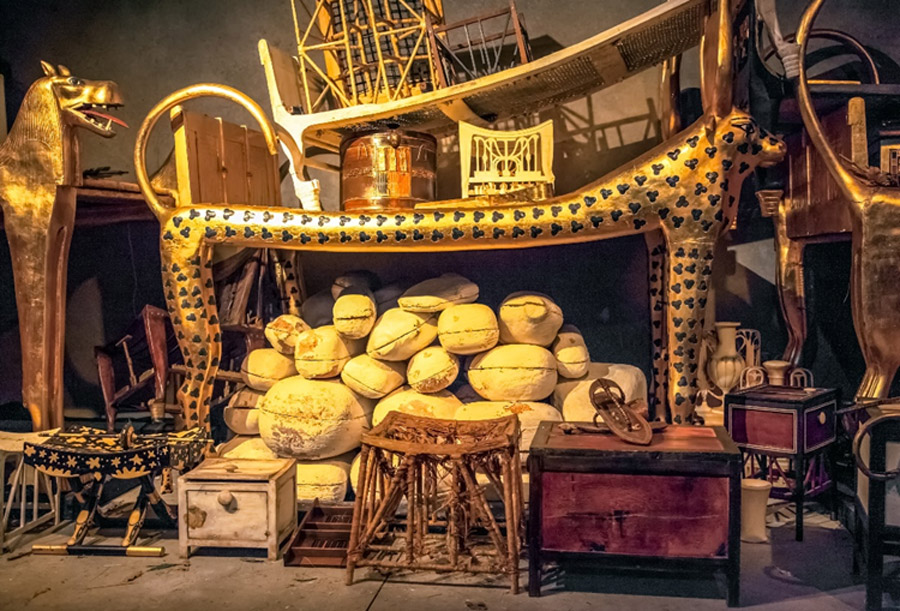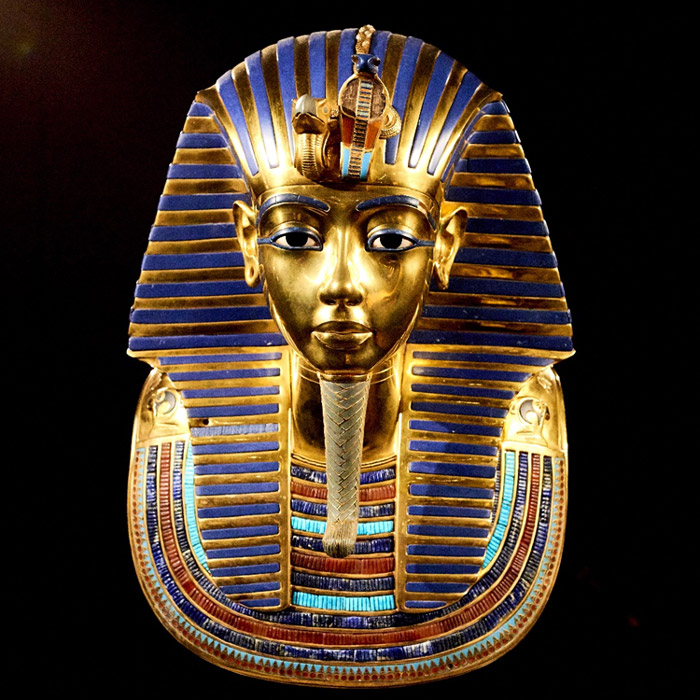A century ago, in 1922, a sensational discovery was made in the Valley of the Kings, the ancient necropolis of the pharaohs of Egypt. Here, in a small set of chambers amidst much larger tombs ransacked for their valuables in antiquity, was an almost intact burial.
Although there was so evidence that the tomb had been re-entered in ancient times, the burial chamber itself not been looted and was filled with treasures. And at the center of a nested set of gilded wooden shrines, wearing his famous funeral mask of lapis lazuli and gold, was the mummy of Tutankhamun.
The treasures inside the tomb, densely packed and still arranged as intended, were a wealth of information about the young king Tut, the 18th dynasty of ancient Egypt he ruled, and the funerary customs followed in his interment. Alabaster jars, a great statue of Anubis, trumpets, chariots and a canopic chest containing the king’s internal organs were arranged in the chambers surrounding Tut’s sarcophagus.
But, amongst the treasures the archaeologists found in the tomb was one that defied explanation. Among the thousands of items in the tomb was a small dagger, made of iron.

But, for the Egyptians, the iron age was still 250 years in the future, and an iron dagger would surely have been as alien to Tutankhamun as an iphone would be to Napoleon. From where, then, did King Tut get his iron dagger?
The Discovery of the Dagger
The systematic and careful excavation of Tutankhamun’s tomb was a slow process, taking years. The dagger was not investigated until 1925, the third year of the excavation, but it was immediately clear that this was a high-value artifact.
The dagger was about a foot long, and fitted into a handle of gold. It was also found with an ornamental gold sheath, which along with the handle was highly decorated. But what stunned the archaeologists was that the blade of the dagger was made of iron.
Such a find was almost unheard of. At this stage in history, iron age technologies were in their global infancy, and the iron age in Egypt was still centuries away. For the young King Tut to have an iron dagger asked many questions.
Were there trade routes modern historians were unaware of, to allow Tutankhamun to acquire an iron dagger? Was Egyptian metallurgy more sophisticated than thought, and was there therefore some other limiting factor which prevented iron weapons being more available for the Egyptians?
Where did it Come From?
Tutankhamun is believed to have died in 1323 BC. It would be very unlikely for the dagger to have been added to the tomb later, as re-opening a royal tomb to add further treasures hundreds of years after the pharaoh was interred was unheard of.
The earliest evidence of Iron Age technology emerged in c1200 BC in the ancient near east, India, and south Asia. If Tut acquired his dagger from these sources, it would be an unique example in history, and would require the Iron Age to be backdated at least a century. This clearly cannot be where the dagger came from.
Perhaps the answer comes from the dagger itself. X-ray analysis determined the exact composition of the dagger: the blade is made up of iron mixed with cobalt and nickel traces. And here, it would seem, the archaeologists were on firmer ground.
This combination of material is only known to occur naturally from one source: a meteorite. Could this dagger be, in the truest sense of the word, extraterrestrial?
Iron smelting was extremely rare during the time of King Tutankhamun’s reign. It was so rare that the price of iron was higher than that of gold and iron as a material wasn’t commonly used even by royalty.
But iron smelting did exist, when the raw materials could be found. Its principal purpose was for ornaments, artistic gifts, and ceremonial reasons. Indeed, other objects of iron were found in the tomb, small trinkets which shed a fascinating light on the nascent technology of ironworking among the super rich.

But, even then the iron dagger was an oddity in the tomb and archaeologists hazard a guess that the dagger was a gift to the young Pharaoh from some neighboring territories. Someone, it seems clear, saw the value of this silvery, extremely hard material in the creation of weaponry.
Proving the Origin of King Tut’s Dagger
The iron meteorites that smash onto the Earth’s surface are formed within the metal-heavy cores of planetesimals. The planetesimals are small bodies within the protoplanetary debris disk that orbited around the sun during the early stages of the Solar System.
- Treasure of the Sands: Lost Egyptian “Golden City” Found near Thebes
- The Mysterious “Set”: An Ancient Egyptian Cryptid?
Because of the conditions under which they were formed, these iron meteorites contain significant amounts of nickel and cobalt, just like Tutankhamun’s dagger. On the other hand, the iron ores mined and extracted from the outer crust of Earth consist of only trace amounts, typically less than 1% of cobalt or nickel.
King Tut’s dagger consists of 11% nickel and strong traces of cobalt, and modern analysis of the material confirms it is exactly the composition expected from a meteorite. The young pharaoh was carrying a dagger that was literally out of this world.
Would it even be possible to identify the exact meteorite the dagger was fashioned from? Intrigued by this possibility, researchers scoured the historical records searching from any known meteor impact sites within the radius of King Tutankhamun’s empire.
The researchers finally narrowed down around 20 sites, aided by confirming the precise composition of the dagger. After running detailed X-rays, the researchers came to the conclusion that the dagger iron came from the “Kharga” meteorite. This meteorite was discovered by 21st-century researchers in the year 2000, on a limestone plateau near Alexandria.
So it would seem the Kharga meteorite was not discovered in 2000, but rediscovered. It is assumed that the Egyptians would have seen the meteorite fall to earth, and then they might have been able to retrieve this gift from the heavens. This strange, otherworldly material would then have been fashioned as a gift to their king.
Conclusion
In point of fact, this is not the only iron artifact of the Bronze Age. There exists evidence of jewelry, ornaments and other artifacts aside from King Tutankhamun’s dagger, made at this period from rare iron. Much of it may have come from this very meteorite, the Ancient Egyptians leveraged its potential to make their weapons and artistic ornaments.
As of now, only two artifacts from ancient Egypt survive with traces of meteorite origin. Aside from the dagger of King Tut, only blackened iron beads are known of. Discovered in 2013, they were beaten out of meteorite fragments.
There may well be more iron artifacts of meteoric origin out there. But for now, King Tut’s alien weapon stands as the only real evidence of this exploitation of such an unusual raw material. Who knows what mystical, divine properties the ancient Egyptians saw in this metal from the stars.
Top Image: How did King tut have an iron dagger in the Bronze Age? Source: -Merce- / CC BY-SA 2.0; Olaf Tausch / CC BY 3.0.
By Bipin Dimri